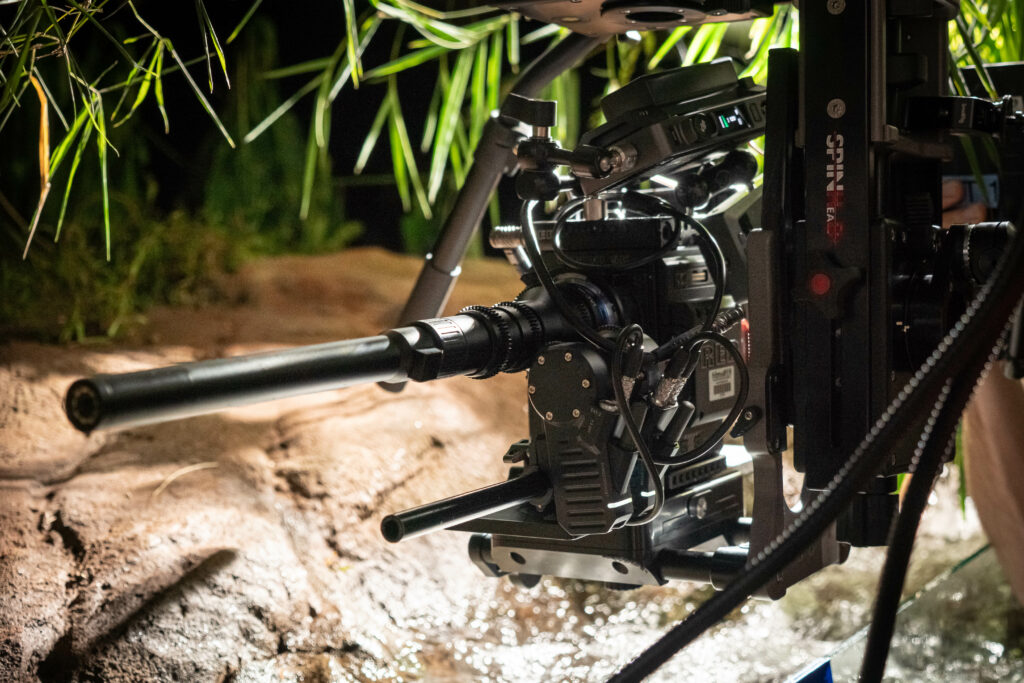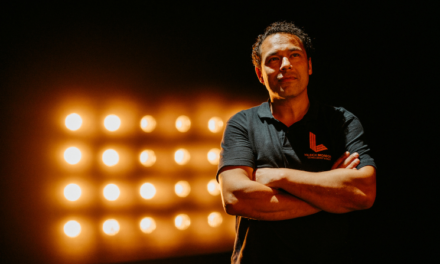Shooting shrimps in Thailand…
The Chaing Mai province in mountainous northern Thailand, is known for its traditional handicrafts, woodcarving, weaving, silverwork, plus a variety of animals including elephants, tigers, monkeys, snakes and… shrimps.

Cartoni on Location Thailand
Freshwater shrimps live in rivers and streams. They are typically small, measuring only a few inches in length, and have a pale brown or green coloration. These shrimps are omnivorous and feed on both plant and animal material and are an important food source for many fish and are a popular food in Thailand, eaten cooked or raw. In the early 1990s Japanese photographer Hiroshi Suga became fascinated by the tiny crustaceans he saw while vacationing in Thailand remarked: “They were so small, yet so beautiful.” Maybe this comment may have come back to Duncan Parker’s mind and made him decide to shoot a documentary on them.
Duncan, a native of UK’s Greater Bristol Area, is a renowned Expeditionary nature documentary filmmaker and Director of Photography, who has been capturing stunning images of the natural world for over 10 years, worked on National Geographic’s Hostile Planet, BBC’s Planet Earth II, BBC’s Natural World, CATS, BBC’s Siberian Tiger, BBC’s Expedition Burma and the BBC’s Wild Japan. Duncan also leads an in-house technology lab for the BBC natural history unit.

Duncan Parker
On his assignments Duncan uses a vast array of camera formats, from Sony FX6, FX3 to A7S, to specialist low light cameras, grips, and accessories. He gained the flexibility to shoot in a variety of styles, observational hand-held, presenter-led pieces to camera, wildlife macro and long lens. “I have always had a particular passion for working on conservation films that showcase the local people and their understanding of the environment around them…being a passionate photographer and trained conservationist, I enjoy making films that can make a difference in the world.” He told us.
How did you start?
“When I was a kid, I met Miles Badgly, a wildlife photographer that lived in the woods near my house in Wales” He opened my eyes to wild animals and the joy of capturing images of them. After doing lots of placements at production companies I finally managed to get a runner job at the BBC Natural History unit and then moved into camerawork from there. I have a real passion for telling stories about people who are intwined by nature. I am looking to work on more feature films/ documentary about the climate, water shortage and nature connection in the future.”
Over the years Duncan gained the flexibility to shoot in a variety of styles, observational hand-held, presenter led pieces to camera, wildlife macro and long lens. He always had a particular passion for working on conservation films that showcase local people and their understanding of the environment around them. After studying Wildlife Conservation Biology, he worked at BBC Bristol and went on to freelance as a camera assistant on a variety of natural history and documentary shoots, before running a small-scale production company and camera innovation space.
Where was your Thailand location?

On Location Thailand
“The location of this shoot was mainly filmed in a specially constructed river set where we could hold the shrimp for a short time while we filmed their behaviour and details, we also filmed in the wild to be used together with these more detailed shots… These river shrimps we filmed has been one of the hardest animals I have ever filmed.” And continues…” We spent long nights just waiting for behavior, but other night packed with filming and when filming in the rapids at night we had a safety team keeping us from falling into the river as it rushes past us at, I could feel the speed of the river on my back, all lit by a few lights to allow us to film the fluorescence and matching behavior“.
What special gear did you use?
“Another complication with our shoot was that the action took place underwater so not only did we want to add movement to the shots while filming we also wanted to film underwater with the Lowa Probe lens. This is often hard to mount but with the Cartoni Spin Head we had the ability to mount underslung so that it was very close to the water’s edge but still allowing full movement. When using the long probe lens mounting it correctly is one challenge but the other is being able to mount it and add motion to the shots. The Spin Head allowed us to do robotic type moves (often only found in animation films) in a lighter weight package.”
The Spin Head can be rotated 360 degrees, so you can film your tiny shrimp from any angle without having to move the camera. This makes it possible to film tiny animals in a creative way, without any disturbance from the camera movement. The Cartoni Spin Head is also a tripod head that allows users to quickly and easily spin their camera around to get the perfect shot. It is made of lightweight aluminum and has a built-in spirit level for accurate alignment. It also has a quick-release plate for easy attachment and removal of the camera. The Lowa Probe lens is a special lens that is designed to film underwater, and it gives a smooth and realistic look to the footage. “We managed to get some great footage and it really helped to add movement and life to the shots. Often the problem when focusing on very small subject, is that moving the camera can make a lot of disturbance in the shot unless on a slider system. With the use of the Spin Head, we could move the camera in several plains across the filming area following the animal as it moved around.”
Duncan continues…” The dampening and the Fluid Head in every axis really gave us creativity to smoothly spin around an object or slowly drift across the back of an animal, it was a real game changer when filming very small subjects. The mounting of the Spin Head was quite straight forward. It was off a scaffold H frame supported by four Avenger Stands, with a 150mm bowl mount Slider put underslung so that you could move the Spin Head left to right, but still utilise the full possibilities if movements underneath. It really opened doors to the possibilities of cinematic movement in your shots. I think one of my favourite things that the Cartoni Spin Head is it allows you to create moves while filming. I have used other motion control rigs which you sit electronically but this often is time intensive to set keyframes and can be as reactive to the subject you are filming. I feel the Spin Head if used in more classic scenarios like interviews, observation documentary or drama when the area you’re working with is localised, the DOP or Director will be able to react to the subject they are filming more often and add movements not previously seen in the filming world, to show different angles to a familiar story. I think the Spin Head would be great for a sports documentary as it would be able to capture the action from all different angles and really give the audience a sense of being in the middle of the game.”
During this shooting did you have the Focus 22 as well?
“Yes, I did. The Focus 22 was mainly brilliant, but I found that I was using it right at the end of its payload. Otherwise, a very well designed and nice Fluid Head to use on this trip. The Cartoni products are very versatile and durable. They are also very easy to use, which makes them a great option for anyone looking for an easy to use and reliable product. Cartoni makes such a range of products that opens possibilities to getting the camera in the perfect position without compromise. They are ruggedly made, able to withstand hostile environments like the jungle or being submerged in a river. The quick release system on the SDS tripod works seamlessly and is a pleasure to use when filming interviews or set up shots. I would highly recommend the Cartoni brand

Close up of Cartoni
What could we improve?
“As I said the Focus 22 didn’t quite give me enough payload of a long lens or slider mounted with various bits of kit. I think some extra bridge plates would be helpful when shooting on Sony cameras to allow the snap plate to connect nice and cleanly with the base of the camera. For example, when using with the Sony FX6 or the Sony FX3 which are not used much in our work but when used the connection to the head is strong and solid. Maybe you already have this bridge plate, but it would be a useful aspect to offer… I really enjoy the colouring and the look. the spikes on the base of the sticks work well in mud and on sand but possible could create a place to hold the rubber feet in the body of the tripod rather than in the case so that when you need to film on rock or a concrete floor you have them to hand. I am excited to see what the Spin Head could be used for in the future. I did have to get some plates made up, to make it fit onto my slider unit to allow the Michell mount to attach so maybe this is something you could design and make as mounted to a slider really opens doors to what is possible with the head.”
“I want to take the opportunity to really thank Cartoni for letting me test and use the Spin Head on our shoot, it’s always exciting to be pushing boundaries of what is possible with your kit. I have enjoyed working with some great production teams, getting me to some very remote and challenging locations. When I am not filming, I spend my time climbing and building filming contraptions or furniture in a workshop in Pensford. I am always up for chatting about film projects and camera innovations and gear…and whenever you have a new product, I’ll be glad to test it.”
Jacques Lipkau Goyard
All Images ©Duncan Parker






